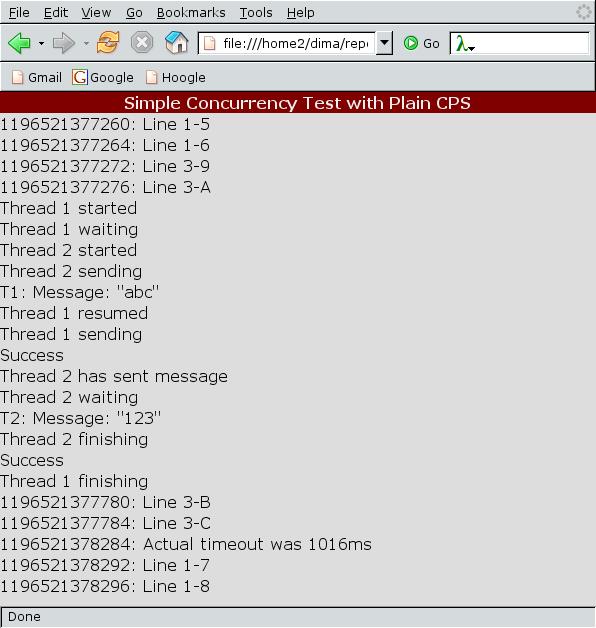Difference between revisions of "Concurrency demos/Haskell-Javascript concurrency"
m (Typeo) |
(Added link to the demo program) |
||
| Line 137: | Line 137: | ||
<small>'''Fig. 1:''' Web browser window showing output of the test program</small> |
<small>'''Fig. 1:''' Web browser window showing output of the test program</small> |
||
</center> |
</center> |
||
| + | |||
| + | ==Try it out== |
||
| + | |||
| + | The compiled HTML page of this demo program is accessible at: |
||
| + | |||
| + | http://darcs.haskell.org/yhc/web/jsdemos/ContTest.html |
||
Revision as of 05:41, 22 November 2007
Introduction
This piece of code is intended for compilation to Javascript via Yhc Javascript Backend and loading into a web browser.
The program is written in monadic style, but it is based on the Continuation Monad.
When started, the main function forks out three pseudo-threads, and exits. Each thread outputs some lines of text and terminates. Each line printed contains absolute timestamp obtined via Javascript function newDate.getTime(). Explicit delays are used to yield control to other threads.
Program
-- Test of Control.Monad.Cont in Javascript
module ContTest where
import UnsafeJS
import Control.Monad
import Control.Monad.Cont
import CDOM.Level2.DomUtils
import DOM.Level2.Dom
import DOM.Level2.Html2
import DOM.Level2.HTMLElement
import DOM.Level2.HTMLDivElement
import Debug.Profiling
-- Output a line of text into browser's window.
-- tmf: boolean value instructing to output timestamp when True
-- cls: stylesheet class name
-- txt: text to output
-- doc: reference to the owner document
-- par: parent element where text will be output
putLineTm = putLine True
putLine tmf cls txt doc par = do
tm <- getTimeStamp 0
t <- mkText doc $ (if tmf then (show tm ++ ": ") else "") ++ txt
d <- mkDiv doc >>= set'className cls
addChild t d
addChild d par
-- Main function. References to the document and document body will be passed
-- to every thread for simplicity. All output goes into the document's body.
-- In our example all computations have type Cont Bool x. This makes sense
-- because Javascript event handlers are expected to return a boolean value.
main = (`runCont` id) $ do
doc <- getHTMLDocument
body <- documentBody doc
putLine False "title" "Simple Concurrency Test with Control.Monad.Cont" doc body
-- Fork three pseudo-threads.
forkCont $ step0 doc body
forkCont $ step1 doc body
forkCont $ step3 doc body
return True
-- Home-grown continiation delimiter function. Passes remainder of the
-- whole computation to a given function and forces the whole computation
-- to complete by returning a final value. Something similar to returning
-- a final value in plain CPS instead of invoking the continuation.
-- f: function which the remainder of the program will be passed to.
-- Remainder will not be evaluated.
-- r: final value of the whole computation that the latter will be
-- terminated with.
delimit f r = Cont $ \c -> runCont (return 0) $ \a -> f (runCont (return a) c) r
-- A primitive to fork out a thread. See the Yhc/Javascript Programmers Guide
-- for the implementation of forkAfter; briefly, it saves the continuation
-- in a global Javascript object, and calls window.setTimeout to execute
-- the saved continuation after the timeout expires. Thus effects like
-- forking parallel thread and cooperative concurrency may be achieved.
-- As follows from the function source below, it yields execution to whatever
-- given as `x' (which must return a final value of the same type as
-- the "parent" thread), while the remainder of the parent will be started
-- after a minimal timeout. The "child" thread is expected to be courteous
-- to its parent and yield execution shortly.
forkCont x = delimit (forkAfter 0) (runCont x id)
-- A primitive to yield execution for a given interval (in milliseconds).
-- It just sets the timeout desired (0 is OK, but it of course will be longer)
-- and terminates the whole computation with final value of True.
yield n = delimit (forkAfter n) True
-- Thread 0. It also features callCC to make sure it is compatible with
-- our home-grown delimiter. Within callCC's nested computation, actual
-- timeout is measured as pair timestamps before and after yield. Output
-- continues then, and finally the timeput value is passed back to callCC.
-- As output shows, line 0-3 is printed after the thread is resumed, so
-- the delimiter works from any depth.
step0 doc body = do
putLineTm "" "Line 0-1" doc body
tmm <- callCC $ \tdiff -> do
putLineTm "" "Line 0-2" doc body
t1 <- getTimeStamp 0
yield 1000
t2 <- getTimeStamp t1
putLineTm "" "Line 0-3" doc body
tdiff t2
putLineTm "" "Line 0-4" doc body
putLineTm "" ("Actual timeout was " ++ show tmm ++ "ms") doc body
return True
-- Two other threads are nothing spectacular, only they have different
-- timeout lengths, so thread 3 will wake up first.
step1 doc body = do
putLineTm "" "Line 1-5" doc body
putLineTm "" "Line 1-6" doc body
yield 1000
putLineTm "" "Line 1-7" doc body
putLineTm "" "Line 1-8" doc body
return True
step3 doc body = do
putLineTm "" "Line 3-9" doc body
putLineTm "" "Line 3-A" doc body
yield 500
putLineTm "" "Line 3-B" doc body
putLineTm "" "Line 3-C" doc body
return True
Output
The figure below shows contents of the web browser window after running the test program above. Actual timeout value is of course different in each run of the program.
Fig. 1: Web browser window showing output of the test program
Try it out
The compiled HTML page of this demo program is accessible at:
